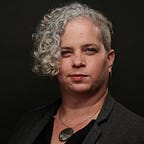What can journalism learn from collaborative futurism?
News has been called the “first rough draft of history.” But what about journalists who, rather than chronicling the present, are passionately imagining the blueprint for what comes next?
As I noted in my introductory post on the New/s initiative — which I’m leading here at the Guild of Future Architects with support from the Ford Foundation —some reporters, editors, and technologists are busy building the future of journalism itself to make it more equitable and actionable. We aim to help them incubate those efforts. But we are also seeking to connect with others applying the questions and approaches of futurism in their reporting—in domains from health, to transportation, to the environment and beyond.
In the months to come, we’ll explore what “speculative journalism” approaches can accomplish that traditional reporting can’t. For example, some creative journalism projects combine reporting with speculative fiction, and forecasting. Take Rose Eveleth’s Flash Forward podcast, which presents a scenario about a possible future and then investigates how possible it might actually be. Or see Slate’s “Future Tense Fiction” series — which tackles current events through short stories as part of a larger partnership with New America and Arizona State University.
Other reporters practice “predictive journalism” — which uses data to forecast shifts in society, demographics, the labor market, elections, and more. Such forward-looking methods, already plentiful in beats such as technology and investing, have exploded during the pandemic, as journalists struggled to imagine how the world might change as a result of massive, unprecedented disruptions. This has put sometimes unsustainable pressure on reporters to parse complex life-or-death possibilities in real time.
How are such reporters taking responsibility for the ways in which their stories might influence people’s lives? And how do audiences interact with and find uses for both frightening and hopeful stories of events yet to come?
The New/s initiative will take these questions a step further by engaging journalists in the Guild’s signature discipline of Future Architecture, developed by the organization’s founder, Sharon Chang. In the Future Architecture framework, the Guild brings individuals together to collectively imagine how society might transform to become more just and cooperative.
Unlike other futurism efforts, the point of these sessions is not just to make forecasts—but instead to surface the types of futures that the group is yearning to inhabit, and write narratives and scenarios that bring them to life. This exercise in radical imagination sets the stage for mapping out ways to shift entrenched systems that are blocking progress, and for building projects and solutions that can drive social change.
Want to see these methods in action? Check out the Guild’s newly released report: Portals to Beautiful Futures: Trends to Watch in 2021 and Beyond, produced in collaboration with Omidyar Network. Drawing from the many sessions the Guild has hosted since 2019, this report combines speculative fiction, analysis, research, and interactive elements to prompt discussion around four provocations:
- What if shared well-being became the standard of success for our nations?
- Are we ready to move from an era that rewards extraction to one that prioritizes regeneration?
- How will we move from an era of destabilizing information into an age of trusted wisdom?
- Can we dismantle industrial-age silos between work, home, education, play, and community?
With the New/s initiative, we hope to invite journalists to experience the methods of Future Architecture, and reflect on how they might inform their sense of what their own work can accomplish. We aim to share a mix of related research and tools, and to host interdisciplinary sessions designed to bring media makers together with experts outside of the field to broaden discussions about what’s possible.
In the process, we also hope to uncover ways in which journalists can turn their considerable skills of synthesis, storytelling, trendspotting, truth-seeking, and deep consultation with sources into not only new forms of reporting, but also new career pathways and routes to sustainability. Just as the Guild is dedicated to helping future architects to find support and forge a living, we hope to support those within the field of journalism to do the same.
In the long run, our goal is to increase the number of journalists who are adept at speculative thinking and co-creation. In turn, we hope this will lead to more reporting that takes a longer-range view of how we might promote equity, justice, and democracy.
We know that for some, Future Architecture will feel like a stretch. The practice is rooted in values rather than striving for objectivity, and is open-ended and playful in ways that might challenge those accustomed to delivering authoritative accounts of the day’s events.
But we also know that journalism itself is in a period of rapid transformation and soul-searching — a state of mind well suited to the processes of collective reimagination. As the editor of the Columbia Journalism Review writes in his recent introductory note for what they call “The Existential Issue”:
Since last spring, for all the excellent pandemic reporting we’ve seen — coverage that saved lives — the media’s shortcomings have also been on painful display: the inability to focus on multiple, interconnected stories; a willingness to be distracted by demagogues and disinformation; the shameful silencing and sidelining of audiences and colleagues of color.
We now face a choice between an incremental return to where we left off and a more fundamental transformation of what we’re about. …We have reached a pivotal, promising moment, charged with reconceiving the nature of our industry. It is an opportunity to do nothing less than remake journalism.
We agree. That’s why we launched the New/s initiative—not only to rethink the future of journalism, but to grapple with how more inclusive and intentional journalism can itself help transform society.
We look forward to imagining what might come next with all of you.
